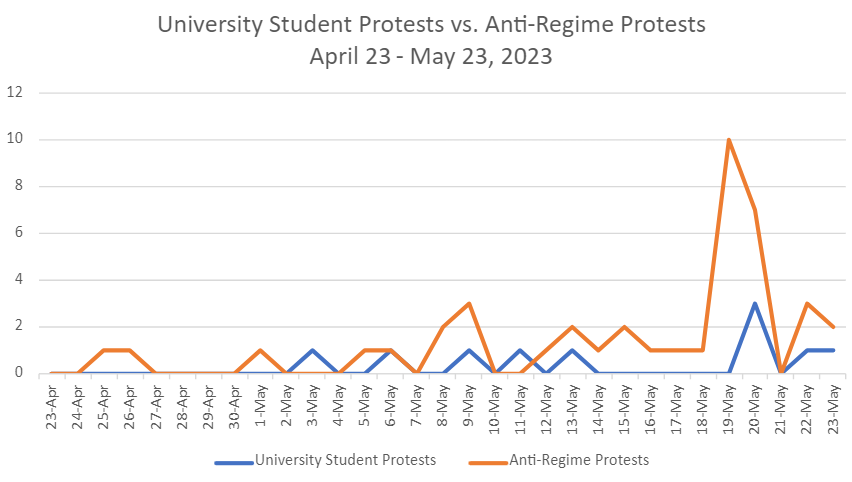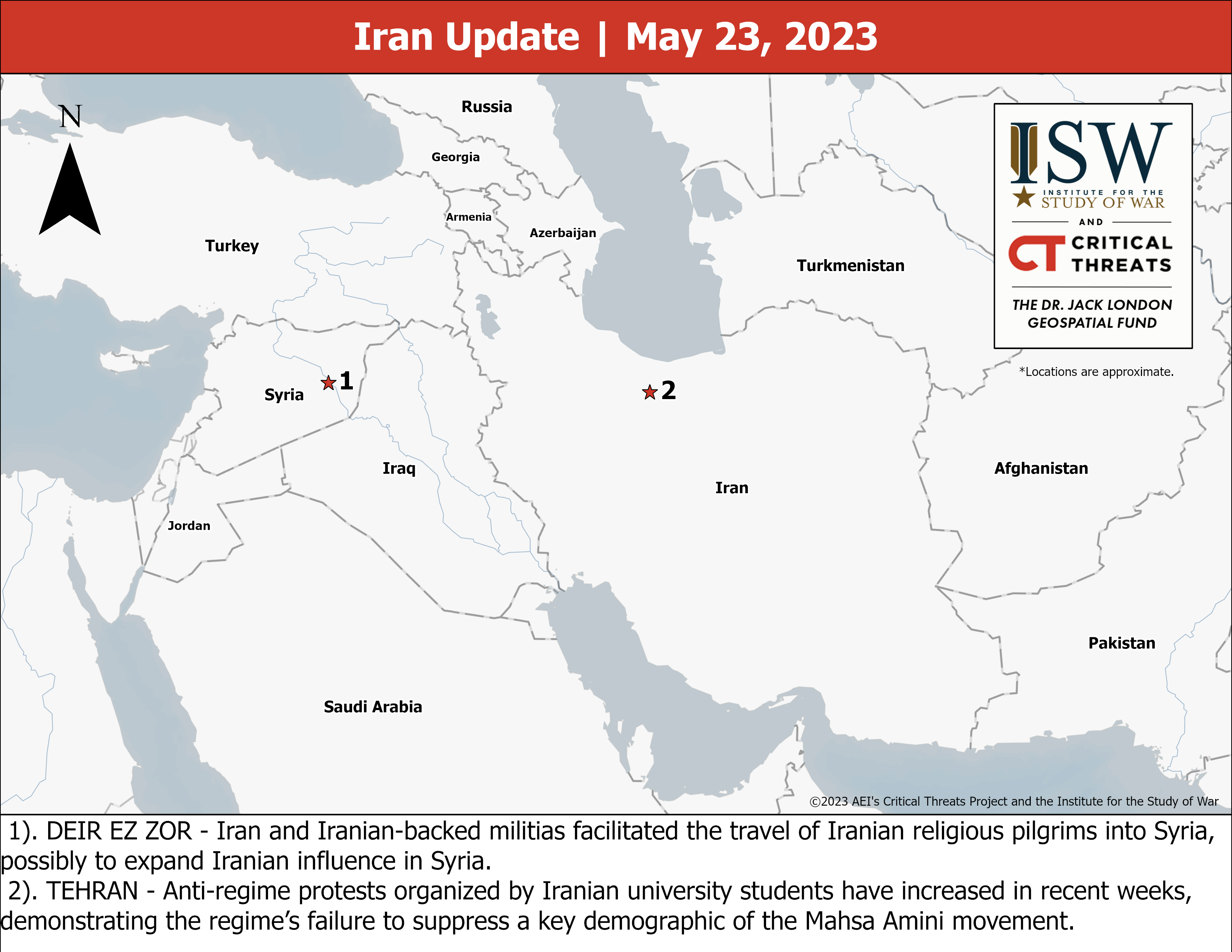Johanna Moore, Annika Ganzeveld, Ashka Jhaveri and Kitaneh Fitzpatrick
The Iran Update aims to inform national security policy by providing timely, relevant, and independent open-source analysis of developments pertaining to Iran and its Axis of Resistance. This update covers political, military, and economic events and trends that affect the stability and decision-making of the Iranian regime. It also provides insights into Iranian and Iranian-sponsored activities abroad that undermine regional stability and threaten US forces and interests. The Critical Threats Project (CTP) at the American Enterprise Institute with support from the Institute for the Study of War (ISW) provides these updates Monday through Friday. To receive Iran Updates via email, please subscribe here.
Key Takeaways
1. Iran and Iranian-backed militias facilitated the travel of Iranian religious pilgrims into Syria, possibly to expand Iranian influence in Syria.
2. Anti-regime protests organized by Iranian university students have increased in recent weeks, demonstrating the regime’s failure to suppress a key demographic of the Mahsa Amini movement.
Iranian Activities in the Levant
This section covers Iranian efforts to consolidate and expand Tehran’s economic, military, and political influence throughout the Levant and especially in Syria. This section examines some of the many campaigns that Iran is pursuing to achieve this strategic objective. CTP will update and refine our assessments of these campaigns over time and in future updates.
Iran and Iranian-backed militias facilitated the travel of Iranian religious pilgrims into Syria, possibly to expand Iranian influence in Syria. An unidentified source cited by Eye of Euphrates reported that Iranian-backed militias escorted 15 buses operated by the Qalaa Company through the Albu Kamal border crossing carrying Iranian religious pilgrims to Albu Kamal on May 16.[1] The Qalaa Company is closely affiliated with the Iranian-affiliated Syrian Arab Army (SAA) 4th Division Commander Maher Assad. IRGC Quds Force, Lebanese Hezbollah (LH), and Iraqi Popular Mobilization Forces then coordinated transportation for religious pilgrims traveling into Syria and to various religious sites. Iran has established schools, cultural centers, and has converted Sunni mosques to Shia mosques in Deir ez Zor Province. Religious pilgrims from an Iranian-backed militia also bought at least 10 homes in Sheikh Yassin and Hamidiyeh neighborhoods, Deir ez Zor City on May 23 with the assistance of the Jihad al Binaa Organization. Jihad al Binaa is an LH-run and Iranian-funded construction company subject to secondary sanctions as a Specially Designated Global Terrorist entity.[2] CTP previously reported that Jihad al Binaa, the same company purchasing homes for militia religious pilgrims on May 23, began construction on homes for families of Iranian-backed militias and religious pilgrims traveling to Syria and several military infrastructure projects in the Al Rasafa neighborhood, Deir ez Zor City on May 22.[3]
CTP is considering three hypotheses to explain these developments. The first is that Iran and Iranian-backed militias in Syria are operating as security for Shia religious pilgrims traveling to and within Syria. Syria contains several prominent holy religious sites for Shia pilgrims and Iran commonly facilitates pilgrimages to these sites as part of its cultural exchange.[4] Iranian President Ebrahim Raisi signed 15 memorandums of understanding with Syrian President Bashar al Assad on May 3, one of which agreed that Iran would send an additional 50,000 religious pilgrims to Syria.[5] Second, Iran and Iranian-backed militias are facilitating pilgrimages and purchasing homes for pilgrims to proselytize and spread Iranian influence in Deir ez Zor. Iranian leadership has developed local cultural centers within Syrian communities to be converted to the regime’s version of Shia Islam as a means to extend Iranian regional influence.[6] Third, Iran may use religious pilgrim convoys to transport Iranian-backed militants or weapons shipments into Syria. Unidentified sources claimed that IRGC Quds Force militants used religious pilgrims to transport weapons across the Abu Kamal border crossing on February 5 to prevent being targeted in an Israeli airstrike.[7] Syrian security officials also launched an effort on February 9 to identify Iranian-backed militants who had traveled into Syria with Shia religious pilgrims according to a report from Deir ez Zor 24.[8] These three hypotheses are not mutually exclusive and may be occurring concurrently.
Lebanese Hezbollah (LH) conducted a military exercise in southern Lebanon following a recent escalation of the Israeli-Palestinian conflict in Gaza.[9] LH extended a rare invitation to local and foreign journalists to observe the exercise on May 21 ahead of “Liberation Day,” the annual celebration of the withdrawal of Israeli forces from Lebanon on May 25, 2000 on May 21.[10] LH official Hashem Safiedinne said in a speech that the exercises were meant to confirm Hezbollah’s readiness to confront any aggression.
Iranian Domestic Affairs
This section covers factors and trends affecting regime decision-making and stability. CTP will cover domestic politics, significant protest activity, and related issues here.
Anti-regime protests organized by Iranian university students have increased in recent weeks, demonstrating the regime’s failure to suppress a key demographic of the Mahsa Amini movement. Student protests have largely been a response to increased state executions.[11] CTP recorded 10 anti-regime protests organized by Iranian university students since May 1, marking a 150 percent increase in university student protest activity compared to March and April 2023. Five of these demonstrations responded to the regime’s execution of three Mahsa Amini movement protesters on May 19, demonstrating that regime violence still has the potential to trigger unrest. The regime may regard university protests as a more serious threat to its stability than demonstrations organized by other segments of the population--such as retirees--since university students largely spearheaded the Mahsa Amini movement between September 2022 and January 2023.[12] The increase in university student protests encompasses a broader trend of growing anti-regime unrest, as depicted in the graphic below.

[1] https://eyeofeuphrates dot com/ar/news/2023/05/20/8570
[5] https://www.irna dot ir/news/85100772
[7] https://eyeofeuphrates dot com/ar/news/2023/03/05/7656
[8] https://deirezzor24 dot net/حملة-تفتيش-لعناصر-ميليشيا-الحرس-الثور/
[9] https://apnews.com/article/lebanon-hezbollah-israel-exercises-48e1e763e306470713a12eb1c3d25d20; https://twitter.com/JoeTruzman/status/1660307707390459904; https://tasnimnews (dot) com/en/news/2023/05/22/2899516/lebanon-s-hezbollah-displays-combat-capabilities-in-military-drills; https://www.almayadeen (dot) net/news/politics/%D9%85%D9%86%D8%A7%D9%88%D8%B1%D8%A9-%D8%AD%D8%B2%D8%A8-%D8%A7%D9%84%D9%84%D9%87:-%D8%A5%D9%84%D9%89-%D8%B3%D9%84%D8%A7%D8%AD-%D8%A7%D9%84%D9%87%D8%AC%D9%88%D9%85-%D9%88%D8%A7%D9%84%D9%82%D8%A7%D8%AF%D9%85-%D8%A3%D8%B9%D8%B8%D9%85; https://almanar (dot) com.lb/10644218
[10] https://apnews.com/article/lebanon-hezbollah-israel-exercises-48e1e763e306470713a12eb1c3d25d20; https://twitter.com/JoeTruzman/status/1660307707390459904; https://tasnimnews (dot) com/en/news/2023/05/22/2899516/lebanon-s-hezbollah-displays-combat-capabilities-in-military-drills; https://www.almayadeen
(dot)
net/news/politics/%D9%85%D9%86%D8%A7%D9%88%D8%B1%D8%A9-%D8%AD%D8%B2%D8%A8-%D8%A7%D9%84%D9%84%D9%87:-%D8%A5%D9%84%D9%89-%D8%B3%D9%84%D8%A7%D8%AD-%D8%A7%D9%84%D9%87%D8%AC%D9%88%D9%85-%D9%88%D8%A7%D9%84%D9%82%D8%A7%D8%AF%D9%85-%D8%A3%D8%B9%D8%B8%D9%85;
https://almanar (dot) com.lb/10644218

